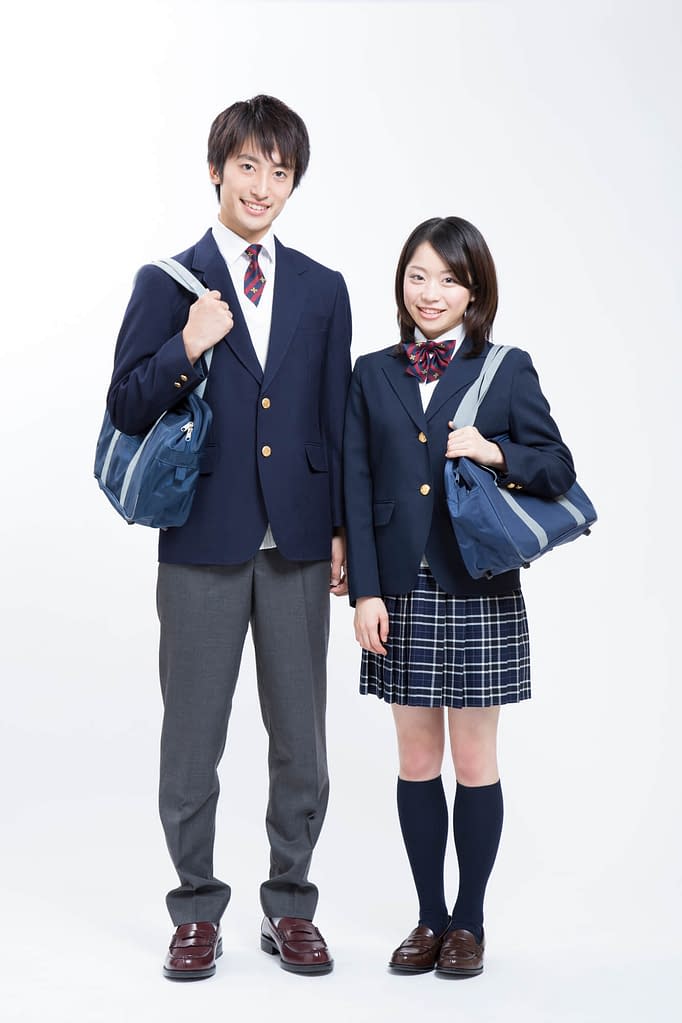- Life & Culture
Japanese schools in anime vs real life
Any fan of Japanese anime has come across storylines set in Japanese schools. These stories leave you wondering: “how are schools I see in anime and real schools in Japan different?”
Remember there are no rules that apply to all schools. There can be differences even in the same city or within the same region. But, some broad trends can apply to most school settings in Japan. Here are a few things you might experience at a Japanese school that doesn’t quite match what you see in Anime.
School uniforms and personal expression
Japan is well known for its uniform culture. Japanese schools can be quite strict about clothing and personal expression. In the average anime, students wear some version of a school uniform.
Most Japanese schools do have a uniform for students. But, real school uniforms are far less fashion-forward than what you see in anime. You won’t find any student sporting pastel skirts or garish colored plaid pants. Uniforms lean toward the conservative. Knee-length skirts and subdued colors like navy, black, or beige are most typical.
The variety of uniforms is also not as wide as what you see portrayed in anime. There are a few basic uniform types. Blazers with pants or a skirt, sailor-style uniforms, and the gakuran – black uniform with a high collar are the norm.

Most schools will change their uniforms according to the season. A summer uniform might trade a dress shirt for a polo shirt or short-sleeved shirt. With a sweater or vest for warmth in winter. The standardization of uniforms can vary from school to school. Some schools allow a little freedom. A student having a choice between a skirt and pants has become more common. Still, some schools have a more prescribed uniform policy.
Often anime characters will have some identifying accessory or style. A silly amount of jewelry or wild hair color is a common anime trope. While it gives the character personality it’s not that realistic. Such expressions of individuality in a Japanese school are rarely tolerated. Most schools have very strict rules to ensure students keep a conservative appearance.
It’s not unusual for schools to dictate hair length or color and to outright ban the wearing of makeup and jewelry. Outliers exist and some schools take a more relaxed approach. Generally, students do follow strict regulations about appearance.
High school students living on their own
Anime may leave you with the impression that Japan is full of high school students living on their own. Although not unheard of it is far less common than anime might have you believe. In most cases if a student is living away from home it’s so they can attend a particularly prestigious school. Even then most schools in that situation would provide a dorm or student housing.
There are some cases where parents will rent an apartment for their child. Students who come from island villages that do not have a high school might fall into this group. Even then students will usually travel home on a regular basis. Most Japanese parents keep close tabs on their children.
Sometimes anime does get it right, well almost…. There are a few things you might encounter in a Japanese school that also appeared in anime.
Club activities
The deep importance of school clubs for junior high and high school students is very real. School clubs are a major commitment for the average student. Lack of sleep and falling behind are common complaints brought on by club schedules. Many schools have a variety of clubs, sports, academics, art, culture, and band clubs are common. But, you’ll be hard-pressed to find an SOS club from “The Melancholy of Haruhi Suzumiya,” or the “Ouran High school host club”.

Student-Teacher relationships
In “My Hero Academia” you might recall All Might and Eraser head visiting their students’ homes. A teacher need not be a superhero to take that extra step. Home visits are standard practice for Japanese teachers.
In fact, homeroom teachers are very involved in their students’ home lives. It’s not only house calls. Teachers often take responsibility for their student’s behavior in and out of school. Take for example a student who shoplifts at a local convenience store after school. It would not be at all unusual for the homeroom teacher to get a call before the parents. The homeroom teacher may even end up apologizing to the parents! In many ways, teachers fulfill the role of moral guides. They are sort of an extension of a student’s parent.
This student-teacher relationship carries over outside of school in other ways. Schools often set a curfew for their students. Schools may also ban students from certain activities outside of school.
Activities like karaoke, shopping at the convenience store, or playing games at an arcade are often restricted. Rules about afterschool jobs are also common. Even the routes students use for getting to and from school may be subject to school rules. Other schools have rules about commuting by bicycle or, or eating snacks on the way to and from school. These rules do not usually get portrayed in anime but they are common and familiar for most students.
Anime can be a fun way to learn about and explore Japanese culture. To experience Japanese schools through anime begin your search here: https://www.cbr.com/best-high-school-anime-ranked/. To see more about real-life Japanese schools check out this school in Kyushu: https://youtu.be/TofGXnjHgzg.
For more about school life and working as an Interac ALT, please see our blog post here.
About the Author

Brian McDonough is a consultant at Interac, Japan’s largest provider of ALTs (Assistant Language Teachers). Originally from the US, Brian has lived in Japan for over 25 years, giving him a unique perspective on the cultural differences and challenges people face when moving to Japan. He has first-hand experience of working in Japan as an American.
